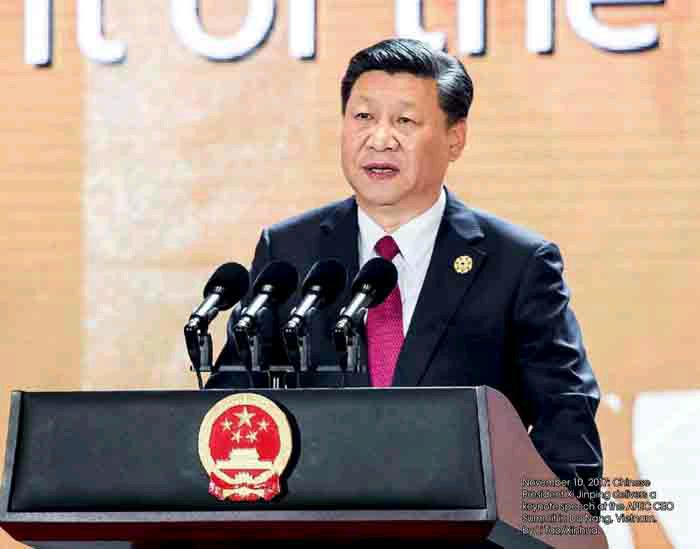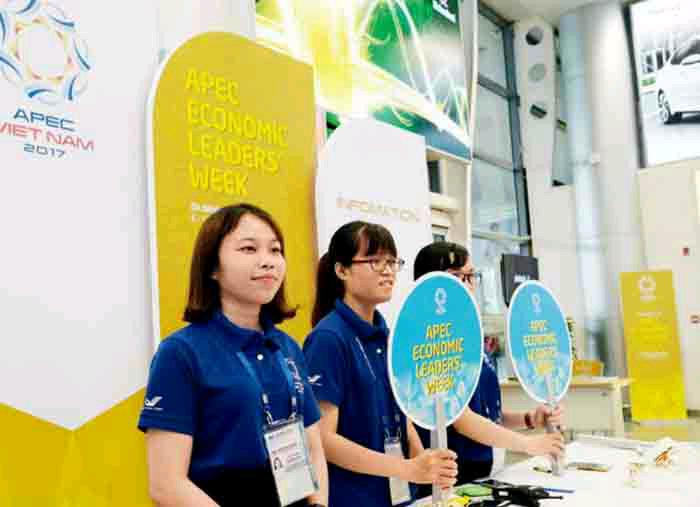A Shared Future for the Asia-Pacific
by+Zhao+Jianglin
The 25th Asia-Pacific Economic Cooperation (APEC) Economic Leaders Meeting was held in Da Nang, Vietnam from November 10 to 11, 2017. The meeting, themed “Creating New Dynamism, Fostering a Shared Future,”produced a declaration that has not only inspired confidence for development in the region, but also laid out new plans for regional development, creating new opportunities for the Asia-Pacific. Highlights from the summit follow:
First, old concepts giving way to new ideas has inspired confidence in AsiaPacific development. Facing the pressure of rising protectionism around the globe, APEC member states—whether they are developing or developed nations—all called for liberalized trade and investment and expressed desire for openness, freedom and transparency from the new perspective of the sharing economy. The meeting called for enhanced connectivity within this region with an eye on making the Asia-Pacific a major engine for global economic cooperation. They will also make every effort to realize the Bogor Goals, a move to build a free trade area in the Asia-Pacific region.
Second, new drivers are being created to break traditional restraints, laying the material foundation for future Asia-Pacific development. This summit focused on the keys to future growth from perspectives of common development and mutual benefits. For instance, the enhancement of mechanisms in this region, including competition policies, ease of doing business, regulatory reform, strengthening economic and legal infrastructure, corporate and public sector governance, and the fight against corruption and bribery, will fuel economic growth.
Third, small enterprises rather than large institutions have created a new foundation for future structural adjustment in the Asia-Pacific region. Small enterprises have always been a key source of innovation, pools for employment and bellwethers for restructuring. This meeting stressed the influence of micro, small and medium enterprises (MSMEs) and introduced a number of new measures to facilitate their development. For example, the APEC Strategy for Green, Sustainable and Innovative MSMEs was approved.
At this important meeting that was built on past achievements to kindle future development, Chinas plan and vision attracted intense attention and praise. China has injected more vigor into APEC. The keynote address delivered by Chinese President Xi Jinping at the APEC CEO Summit in Da Nang, titled “Seizing Opportunity in a Global Economy in Transition and Accelerating Development of the Asia-Pacific,” clearly outlined Chinas concern and pragmatic attitude towards development and governance in this region.endprint
From “a spirit of community”proposed at the first APEC summit to a shared future for APEC countries, Chinas vision has become the guiding principle in the Asia-Pacific. This years summit marked an important milestone in the history of the APEC mechanism. For decades, APEC members have weathered severe storms including the Asian financial crisis of 1997 and the global financial crisis in 2008. Despite the arguments, flinching and hesitation, it is fully realized that APEC members are closely connected with each other in the same community. It is also why “foster a shared future of a peaceful, stable, dynamic, inter-connected and prosperous Asia-Pacific community” has been coined in this years declaration and has become the future aim of APEC.
Chinas plan to promote trade and investment liberalization and build a free trade area of the Asia-Pacific has proved pragmatic and effective. In 2006, APEC leaders first proposed a free trade area for the Asia-Pacific in Hanoi. China resumed the process of building such an area and offered a roadmap to build an open Asia-Pacific economy in 2014. With new threats of protectionism in mind, APEC leaders believe that construction of a free trade area is even more important, largely due to Chinas advocacy.
Chinas ideas on making weak governance strong have been welcomed at the APEC summit. President Xi emphasized Chinas principles on participating in the governance of the Asia-Pacific region.“China will, guided by the principle of upholding justice while pursuing shared interests, actively develop global partnerships, expand the convergence of interests with other countries, and work to foster a new type of international relations featuring mutual respect, fairness, justice, and win-win cooperation,”he declared. “Acting on the principle of achieving shared growth through consultation and collaboration, we will get actively involved in reforming and developing the global governance system to make the international political and economic order more just and equitable.”China is vigorously promoting a new type of Asia-Pacific governance featuring close focus on vulnerable groups, fostering more inclusive societies and projects that improve living standards for every group in the Asia-Pacific region.
President Xi Jinping convinced APEC members with specific statistics that China will “remain an anchor” for development in the Asia-Pacific region. Over the next 15 years, “China will import US$24 trillion worth of goods, attract US$2 trillion inbound direct investment and make US$2 trillion of outbound investment.” Over that time, China will become the biggest direct contributor to Asia-Pacific development and help this region achieve innovative, shared and inclusive growth. endprint
endprint

